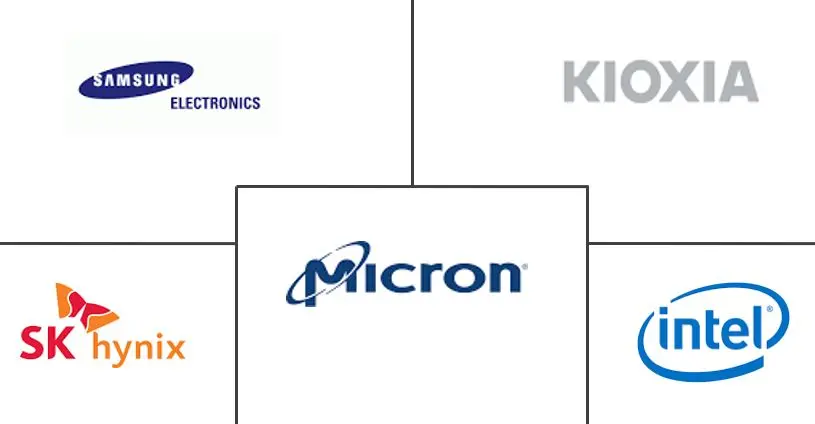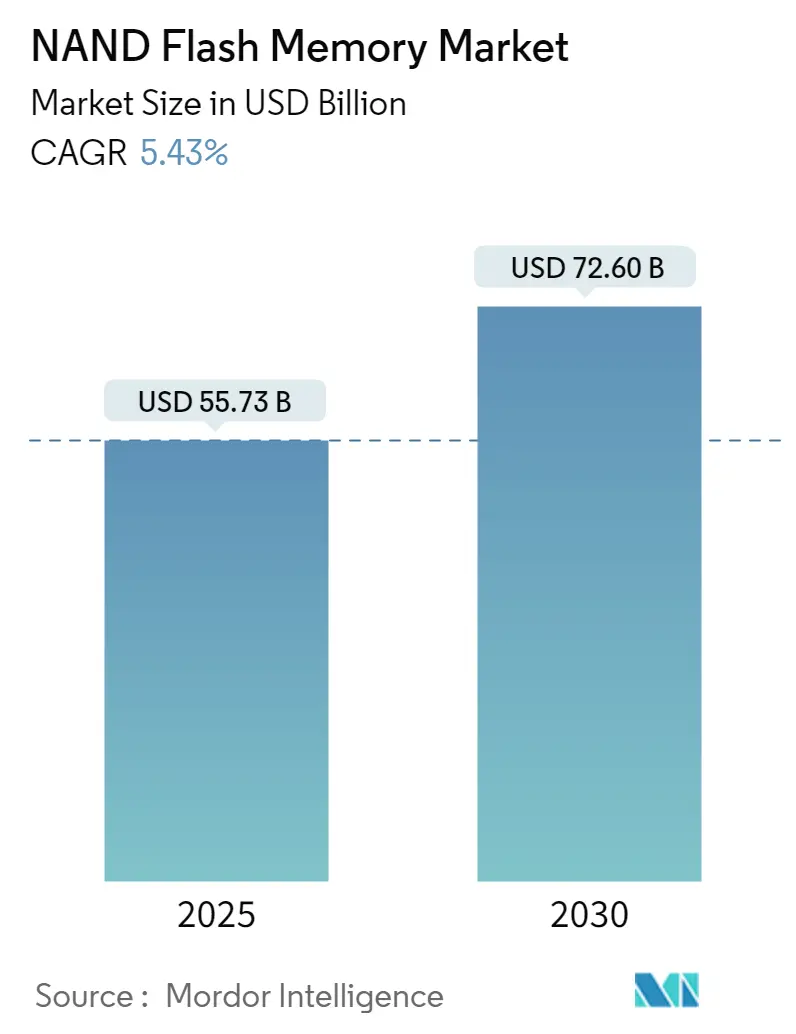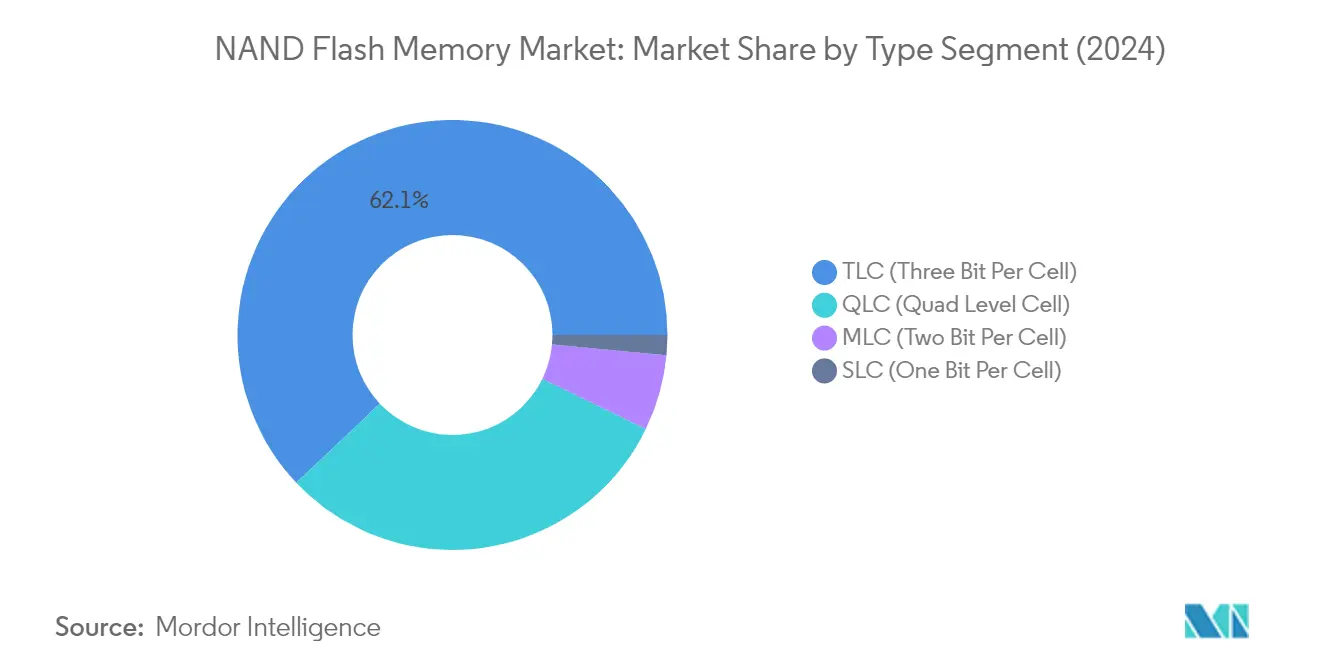NAND Flash Memory Market Overview
The NAND Flash Memory Market size is estimated at USD 55.73 billion in 2025, and is expected to reach USD 72.60 billion by 2030, at a CAGR of 5.43% during the forecast period (2025-2030).
The NAND flash memory industry is experiencing significant technological evolution, particularly in storage architecture and cell density capabilities. Manufacturers are progressively advancing from traditional planar NAND to sophisticated 3D NAND technologies, with companies already developing 192-layer 3D NAND and planning to introduce 256-layer devices by late 2024. This architectural transformation is complemented by the industry's shift toward higher bit densities, with Western Digital's innovative OptiNAND technology delivering a 64GB payload on 20TB class HDDs, demonstrating the industry's commitment to pushing storage density boundaries while maintaining performance and reliability.
The industry landscape is being reshaped through strategic consolidations and substantial investments in production capabilities. Major industry players are actively pursuing mergers and acquisitions to strengthen their market position and achieve economies of scale. A notable example is SK Hynix's acquisition of Intel's NAND unit for USD 9 billion, with integration processes expected to complete by 2025. These strategic moves are accompanied by significant capital investments in research and development, with companies like Samsung Electronics leading semiconductor memory plant investments at USD 36.4 billion for upgrades and expansion of chip plants in Korea and China.
Data security and reliability have become paramount concerns in the NAND flash memory market, driving innovations in encryption and error correction technologies. According to recent industry studies, organizations implementing high encryption standards for data at rest and in motion experienced 29.4% lower data breach costs compared to those with minimal or no encryption standards. This has prompted manufacturers to integrate advanced security features into their products, with companies like Micron Technology introducing vertically-integrated 176-layer NAND solid-state drive with enhanced security functionalities.
The industry is witnessing a dramatic transformation in data storage requirements, driven by the exponential growth in digital content and emerging technologies. Industry projections indicate that global data volume will surge by 61% to reach 175 zettabytes by 2025, necessitating more efficient and higher-capacity flash storage solutions. This growth is prompting manufacturers to explore next-generation technologies like Penta Layer Cell (PLC) NAND, which promises to increase storage density by 25% per cell compared to current technologies, though its commercial introduction has been strategically delayed to 2025 to ensure optimal performance and reliability.
NAND Flash Memory Key Market Trends
INCREASING DEMAND FOR DATA CENTERS
The exponential growth in data generation and processing requirements has made data centers a crucial driver for NAND flash memory adoption. Enterprise-scale data centers require high-performance data storage solutions to handle compute-intensive workloads across collaboration, database/analytics, and business applications. According to industry analysis, compute and database/analytics applications alone account for over 850 exabytes of data center storage capacity, highlighting the massive storage requirements that NAND flash memory helps address. The increasing adoption of artificial intelligence, machine learning, and real-time analytics is further accelerating the need for low-latency, high-capacity data storage solutions in data centers.
The evolution of NAND flash technology, particularly the transition from planar NAND to advanced 3D NAND architectures, has enabled data centers to achieve higher storage densities and improved performance metrics. Major manufacturers are developing specialized enterprise solid-state drives (SSDs) with QLC NAND technology to provide cost-effective data storage solutions for read-intensive data center workloads. The development of 176-layer and 232-layer NAND technologies by leading vendors has enabled enterprise SSDs to deliver capacities exceeding 30TB while maintaining the performance and endurance requirements of modern data centers. These technological advancements, combined with the growing adoption of flash storage in hyperscale and enterprise data centers, continue to drive innovation in the NAND flash memory market.
INCREASING PROLIFERATION OF 5G AND IOT DEVICES
The rapid deployment of 5G networks and the expanding ecosystem of IoT devices are creating unprecedented demand for NAND flash memory solutions. According to industry projections, global 5G subscriptions are expected to reach 4.39 billion by 2027, necessitating high-capacity embedded storage solutions in both network infrastructure and end-user devices. The increased data transmission speeds enabled by 5G networks, combined with edge computing requirements, are driving the adoption of high-performance solid-state drive storage in mobile devices, automotive systems, and industrial IoT applications. Manufacturers are developing specialized NAND solutions with enhanced endurance and reliability specifications to meet the demanding requirements of 5G and IoT deployments.
The industrial automation sector, particularly Industry 4.0 initiatives, represents a significant growth driver for NAND flash memory adoption. IoT applications spanning smart homes, industrial automation, automotive systems, and connected infrastructure require reliable non-volatile semiconductor memory solutions that can operate in challenging environmental conditions. Leading NAND flash manufacturers have responded by developing automotive-grade solutions capable of operating in extreme temperatures ranging from -40°C to 105°C, specifically designed for advanced driver-assistance systems (ADAS) and autonomous vehicle applications. The integration of artificial intelligence and machine learning capabilities in edge devices is further driving demand for high-performance flash memory solutions that can support real-time data processing and storage requirements.
Segment Analysis: By Type
TLC Segment in NAND Flash Memory Market
The Triple-Level Cell (TLC) segment dominates the global NAND Flash Memory market, commanding approximately 62% market share in 2024. This significant market position is driven by TLC's optimal balance of cost-effectiveness and performance characteristics, making it particularly attractive for mainstream consumer electronics and enterprise storage applications. The technology's ability to store three bits per cell provides higher storage density compared to SLC and MLC variants, while maintaining acceptable endurance levels. Major manufacturers have widely adopted TLC technology in their solid-state drives (SSDs), smartphones, and other storage solutions, leveraging advanced controller technologies and improved manufacturing processes to enhance reliability and performance.
QLC Segment in NAND Flash Memory Market
The Quad-Level Cell (QLC) segment is experiencing the most rapid growth in the NAND Flash Memory market, with an expected growth rate of approximately 13% during 2024-2029. This remarkable growth is primarily attributed to the increasing demand for high-capacity flash storage solutions in data centers and cloud computing applications. QLC technology's ability to store four bits per cell makes it an attractive option for cost-sensitive, read-intensive workloads in enterprise storage systems. The technology's evolution has addressed initial performance and endurance concerns through sophisticated error correction algorithms and improved controller designs, making it increasingly viable for broader applications in enterprise and consumer markets.
Remaining Segments in NAND Flash Memory Market by Type
The Single-Level Cell (SLC) and Multi-Level Cell (MLC) segments continue to serve specific niches in the NAND Flash Memory market. SLC technology, despite its higher cost, maintains its relevance in mission-critical applications where reliability and endurance are paramount, such as industrial and automotive systems. MLC technology serves as a middle-ground solution, offering a balance between SLC's reliability and TLC's cost-effectiveness, particularly in enterprise applications requiring moderate endurance levels. Both segments continue to evolve with technological advancements in manufacturing processes and controller designs, though their market share has gradually decreased as TLC and QLC technologies mature.
Segment Analysis: By Structure
3D Structure Segment in NAND Flash Memory Market
The 3D Structure segment dominates the global NAND Flash Memory market, commanding approximately 84% market share in 2024, equivalent to USD 69.73 billion. This dominance is primarily attributed to the technology's ability to stack memory cells vertically, dramatically increasing storage capacity without shrinking cell size. The 3D NAND technology has evolved from 32-layer to advanced configurations of up to 176-layer technology, with research and development ongoing for even higher layer counts. This segment is also experiencing the fastest growth trajectory, with manufacturers increasingly adopting this structure due to its superior benefits, including longer lifespan, faster performance, and lower power consumption compared to traditional 2D structures. Major manufacturers like Samsung, SK Hynix, and Micron are heavily investing in 3D NAND production facilities and advancing their layer technologies to meet the growing demand for high-capacity data storage solutions in data centers, smartphones, and other electronic devices.
2D Structure Segment in NAND Flash Memory Market
The 2D Structure segment, while representing a smaller portion of the market, continues to serve specific niche applications where traditional planar NAND technology remains relevant. This structure places memory chips side-by-side in a single die layer, making it suitable for certain legacy systems and specific industrial applications. The technology has reached its practical scaling limits at around 15-16nm, beyond which further miniaturization becomes technically challenging and economically unfeasible. Despite these limitations, 2D NAND maintains its relevance in applications requiring simpler memory architectures or where cost considerations outweigh the need for higher storage density. The segment continues to serve markets where reliability and established technology compatibility are prioritized over storage density and advanced features.
Segment Analysis: By Application
Smartphone Segment in NAND Flash Memory Market
The smartphone segment continues to dominate the global NAND Flash Memory market, commanding approximately 36% market share in 2024. This significant market position is driven by the increasing storage requirements in modern smartphones, particularly with the proliferation of high-resolution cameras, mobile gaming applications, and multimedia content. The growth in 5G smartphone adoption has further accelerated the demand for higher capacity NAND flash memory storage, as these devices require more storage to support high-speed data processing and content consumption. Additionally, the integration of advanced features like AI-powered applications, augmented reality capabilities, and high-definition video recording has made larger storage capacities a necessity rather than a luxury in contemporary smartphones.
SSD Segment in NAND Flash Memory Market
The Solid State Drive (SSD) segment is experiencing the fastest growth in the NAND Flash Memory market, with a projected growth rate of approximately 7% during 2024-2029. This remarkable growth is primarily attributed to the increasing adoption of SSDs in data centers, enterprise storage systems, and personal computing devices. The segment's expansion is further fueled by the rising demand for high-performance computing solutions, cloud storage services, and the ongoing digital transformation across industries. The transition from traditional hard disk drives to SSDs continues to accelerate, driven by advantages such as faster data access speeds, improved reliability, and lower power consumption, making them increasingly essential for modern computing applications.
Remaining Segments in NAND Flash Memory Market by Application
The memory card, tablet, and other applications segments collectively represent significant portions of the NAND Flash Memory market, each serving distinct use cases and requirements. Memory cards continue to play a crucial role in portable devices, digital cameras, and various consumer electronics applications, offering expandable storage solutions. The tablet segment maintains steady demand driven by both consumer and enterprise applications, particularly in education and professional settings. Other applications, including automotive systems, IoT devices, and industrial equipment, are emerging as important growth drivers, particularly with the increasing integration of smart features and data storage requirements across various sectors.
NAND Flash Memory Market Geography Segment Analysis
NAND Flash Memory Market in North America
North America represents a dominant force in the global NAND flash memory market, holding approximately 30% of the market share in 2024. The region's leadership position is primarily driven by its robust technological infrastructure and the presence of major technology companies. The widespread adoption of cloud computing, artificial intelligence, and IoT applications continues to fuel demand for high-capacity data storage solutions. The region's data center industry remains at the forefront of innovation, with companies consistently upgrading their storage capabilities to handle increasing data volumes. The automotive sector's growing focus on advanced driver-assistance systems (ADAS) and autonomous vehicles has created additional demand for flash memory. The region's strong focus on research and development, coupled with significant investments in emerging technologies, continues to drive market growth. Moreover, the increasing adoption of 5G technology and the subsequent need for enhanced mobile device capabilities have further strengthened the market position of North America in the global NAND flash memory market landscape.
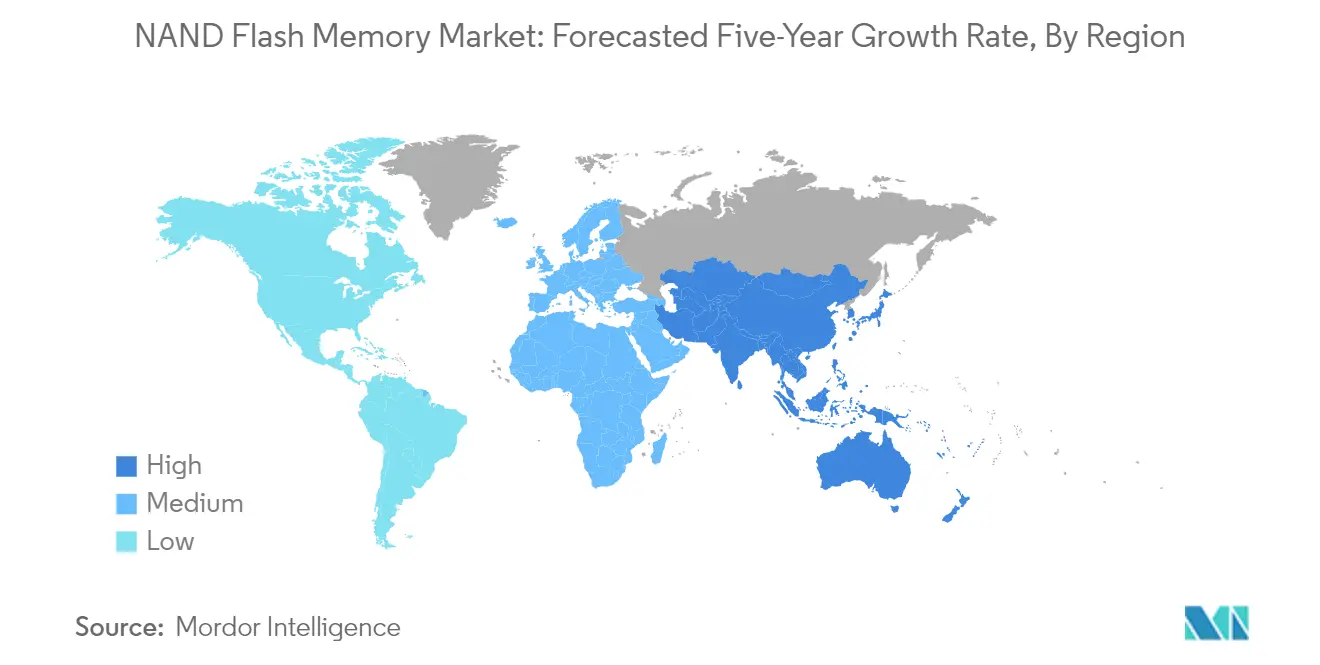
NAND Flash Memory Market in Europe
The European NAND flash memory market has demonstrated robust growth, recording approximately 5% annual growth from 2019 to 2024. The region's market dynamics are significantly influenced by its strong automotive manufacturing sector and increasing digitalization initiatives. The European Union's aggressive push toward digital transformation across industries has created substantial demand for data storage solutions. The region's focus on Industry 4.0 implementation has led to increased adoption of IoT devices and smart manufacturing solutions, driving demand for NAND flash memory. The presence of strong automotive manufacturers and their increasing focus on electric and autonomous vehicles has created a steady demand stream. Additionally, the region's strict data protection regulations have led to increased investments in local data storage infrastructure. The growing emphasis on edge computing and the need for faster data processing capabilities have further accelerated market growth. European countries' commitment to technological advancement and digital sovereignty has created a favorable environment for market expansion.
NAND Flash Memory Market in Asia-Pacific
The Asia-Pacific region continues to dominate the global NAND flash memory market, with projections indicating a robust growth rate of approximately 6% from 2024 to 2029. The region's market leadership is anchored by its strong semiconductor manufacturing capabilities and extensive electronics production ecosystem. Countries like China, South Korea, and Japan continue to drive innovation in NAND flash memory technology, supported by significant government initiatives and private sector investments. The region's massive consumer electronics market, coupled with increasing smartphone penetration, creates substantial demand for flash memory. The rapid expansion of data center infrastructure across developing economies has emerged as a key growth driver. The region's manufacturing prowess, competitive cost structure, and technological capabilities have established it as the global hub for NAND flash memory production. Furthermore, the increasing adoption of electric vehicles and smart devices across the region continues to create new growth opportunities.
NAND Flash Memory Market in Latin America
The Latin American NAND flash memory market is experiencing steady growth, driven by increasing digitalization efforts and growing technology adoption across industries. The region's expanding mobile device market and growing internet penetration have created new opportunities for NAND flash memory applications. Countries like Brazil and Mexico are leading the regional market, supported by their growing manufacturing capabilities and increasing foreign investments in technology sectors. The region's emerging data center market and growing cloud computing adoption have created additional demand for storage solutions. The automotive sector's modernization and the increasing integration of electronic components have further boosted market growth. Additionally, government initiatives promoting digital transformation and smart city development have created a favorable environment for market expansion. The region's growing focus on industrial automation and IoT implementation continues to drive demand for NAND flash memory solutions.
NAND Flash Memory Market in Middle East & Africa
The Middle East and Africa region represents an emerging market for NAND flash memory, characterized by increasing technological adoption and digital transformation initiatives. The region's growing focus on smart city development, particularly in Gulf Cooperation Council (GCC) countries, has created new opportunities for NAND flash memory applications. The expansion of data center infrastructure across major cities has emerged as a significant growth driver. The region's telecommunications sector modernization and increasing smartphone penetration have contributed to market growth. Government initiatives promoting digital transformation and technological advancement have created a supportive environment for market expansion. The growing adoption of cloud computing services and the increasing focus on cybersecurity have further accelerated demand for reliable storage solutions. The region's emerging automotive sector and increasing industrial automation have created additional growth opportunities for the NAND flash memory market.
NAND Flash Memory Competitive Landscape
Top Companies in NAND Flash Memory Market
The NAND flash memory market is dominated by established players, including Samsung Electronics, KIOXIA Corporation, Western Digital, SK Hynix, Micron Technology, and Intel Corporation. These companies are heavily investing in research and development to advance their technological capabilities, particularly in areas like 3D NAND technology, multi-layer cell architectures, and enhanced storage densities. Product innovation is primarily focused on developing higher-capacity solutions with improved performance metrics, especially for data center and enterprise applications. Companies are strengthening their manufacturing capabilities through capacity expansions and modernization of fabrication facilities. Strategic partnerships and collaborations, particularly in emerging technologies like 5G and artificial intelligence, are becoming increasingly common as companies seek to maintain their competitive edge. Operational agility is demonstrated through vertical integration strategies and diversified product portfolios spanning consumer electronics to enterprise solutions.
Consolidated Market with High Entry Barriers
The NAND flash memory market exhibits a highly consolidated structure dominated by large multinational conglomerates with sophisticated manufacturing capabilities and extensive research facilities. These established players have created significant entry barriers through their accumulated intellectual property portfolios, cross-licensing agreements, and capital-intensive production facilities. The market has witnessed strategic consolidation through mergers and acquisitions, exemplified by SK Hynix's acquisition of Intel's NAND business and Western Digital's integration of SanDisk's operations. Regional dynamics are particularly notable in Asia-Pacific, where companies like Samsung and SK Hynix maintain strong manufacturing bases, while emerging players like Yangtze Memory Technologies are gaining ground through government support and technological advancement.
The competitive landscape is characterized by intense rivalry among established players, with competition primarily centered on technological innovation, production efficiency, and cost optimization. Market leaders are continuously investing in advanced manufacturing processes and new product development to maintain their competitive positions. The industry's high fixed costs and economies of scale advantages favor larger players, making it challenging for new entrants to establish a meaningful presence. Vertical integration strategies, particularly in design and fabrication, have become crucial for maintaining cost competitiveness and ensuring supply chain stability. The market also sees significant collaboration between manufacturers and technology partners to develop next-generation flash storage solutions.
Innovation and Scale Drive Market Success
Success in the flash memory market increasingly depends on companies' ability to balance technological innovation with cost-effective manufacturing at scale. Incumbent players must focus on developing advanced technologies like QLC and PLC NAND while optimizing production costs through automation and improved yields. Strategic investments in research and development, particularly in areas like 3D NAND technology and emerging memory architectures, are crucial for maintaining market leadership. Companies must also strengthen their relationships with key customers in high-growth segments such as data centers, automotive electronics, and mobile devices. Building robust supply chain networks and maintaining flexible manufacturing capabilities are essential for responding to market demand fluctuations and ensuring long-term sustainability.
For contenders aiming to gain market share, focusing on specialized market segments and developing innovative solutions for specific applications presents a viable strategy. Success factors include establishing strong partnerships with technology providers and end-users, investing in intellectual property development, and maintaining operational efficiency through advanced manufacturing processes. Companies must also navigate potential regulatory challenges, particularly regarding data security and environmental compliance. The increasing concentration of end-users in sectors like cloud computing and mobile devices necessitates strong customer relationship management and customized solution development. Additionally, companies need to address the growing threat of substitution from emerging semiconductor memory technologies by continuously improving product performance and reliability while maintaining competitive pricing.
NAND Flash Memory Major Players
-
Samsung Electronics Co. Ltd
-
KIOXIA Corporation
-
Micron Technology Inc.
-
SK Hynix Inc.
-
Intel Corporation
- *Disclaimer: Major Players sorted in no particular order
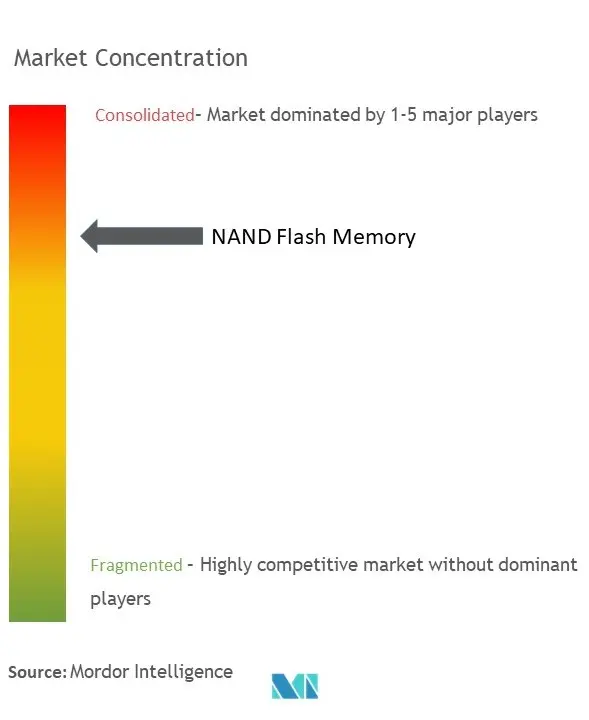
NAND Flash Memory Recent Developments
- October 2023 - Kioxia Corporation and Western Digital Corp. has announced details of their newest 3D flash memory technology. Applying advanced scaling and wafer bonding technologies, the 3D flash memory delivers exceptional capacity, performance and reliability at a compelling cost, which makes it ideal for meeting the needs of exponential data growth across a broad range of market segments.
- August 2023 - SK Hynix has developed 321-layer NAND flash memory for data storage, as the race for more layers of chips and greater data capacity continues in the industry, The 321-layer NAND offers 59% more data capacity per area than the company's 238-layer memory, which entered mass production this year. The new technology is set to enter mass production in the first half of 2025.
NAND Flash Memory Market Report - Table of Contents
1. INTRODUCTION
- 1.1 Study Assumptions and Market Definition
- 1.2 Scope of the Study
2. RESEARCH METHODOLOGY
3. EXECUTIVE SUMMARY
4. MARKET INSIGHTS
- 4.1 Market Overview
-
4.2 Industry Attractiveness - Porter's Five Forces Analysis
- 4.2.1 Bargaining Power of Suppliers
- 4.2.2 Bargaining Power of Buyers
- 4.2.3 Threat of New Entrants
- 4.2.4 Threat of Substitutes
- 4.2.5 Intensity of Competitive Rivalry
- 4.3 Industry Value Chain Analysis
- 4.4 Assessment of Impact of COVID-19 on the Industry
5. MARKET DYNAMICS
-
5.1 Market Drivers
- 5.1.1 Increasing Demand for Data Centers
- 5.1.2 Increasing Proliferation of 5G and IOT Devices
-
5.2 Market Restraints
- 5.2.1 Reliability Issues
6. MARKET SEGMENTATION
-
6.1 Type
- 6.1.1 SLC (One-Bit Per Cell)
- 6.1.2 MLC (Two-Bit Per Cell)
- 6.1.3 TLC (Three-Bit Per Cell)
- 6.1.4 QLC (Quad Level Cell)
-
6.2 Structure
- 6.2.1 2D Structure
- 6.2.2 3D Structure
-
6.3 Application
- 6.3.1 Smartphone
- 6.3.2 SSD
- 6.3.3 Memory Card
- 6.3.4 Tablet
- 6.3.5 Other Applications
-
6.4 Geography
- 6.4.1 North America
- 6.4.2 Europe
- 6.4.3 Asia Pacific
- 6.4.4 Latin America
- 6.4.5 Middle-East and Africa
7. COMPETITIVE LANDSCAPE
-
7.1 Company Profiles
- 7.1.1 Samsung Electronics Co. Ltd
- 7.1.2 KIOXIA Corporation
- 7.1.3 Micron Technology Inc.
- 7.1.4 SK Hynix Inc.
- 7.1.5 Intel Corporation
- 7.1.6 Yangtze Memory Technologies
- 7.1.7 SanDisk Corp. (Western Digital Technologies Inc.)
- 7.1.8 Powerchip Technology Corporation
- 7.1.9 Cypress Semiconductor Corporation
- *List Not Exhaustive
8. VENDOR MARKET POSITIONING
9. INVESTMENT ANALYSIS
NAND Flash Memory Scope of the Report
NAND flash is a kind of non-volatile storage technology that does not require power to retain data. In other words, it is a form of electronically erasable programmable read-only memory (EEPROM). It is programmed, erased, and reprogrammed in large blocks. It's called NAND because, at the circuit level, it's similar to the NAND logic function. The scope of the study covers the market on the basis of the type of NAND and different applications in smartphones, SSD, Memory Cards, and Tablet PC across the world.
The NAND flash memory market is segmented by type (SLC ((one-bit per cell), MLC ((second-bit per cell), and TLC (three-bit per cell), QLC (quad level cell)), structure (2-D structure and 3-D structure), application (smartphones, SSD, memory cards, and tablets), and geography (North America, Europe, Asia Pacific, Latin America, Middle-East and Africa). The market sizes and forecasts are provided in terms of value in USD for all the above segments.
| Type | SLC (One-Bit Per Cell) |
| MLC (Two-Bit Per Cell) | |
| TLC (Three-Bit Per Cell) | |
| QLC (Quad Level Cell) | |
| Structure | 2D Structure |
| 3D Structure | |
| Application | Smartphone |
| SSD | |
| Memory Card | |
| Tablet | |
| Other Applications | |
| Geography | North America |
| Europe | |
| Asia Pacific | |
| Latin America | |
| Middle-East and Africa |
NAND Flash Memory Market Research FAQs
How big is the NAND Flash Memory Market?
The NAND Flash Memory Market size is expected to reach USD 55.73 billion in 2025 and grow at a CAGR of 5.43% to reach USD 72.60 billion by 2030.
What is the current NAND Flash Memory Market size?
In 2025, the NAND Flash Memory Market size is expected to reach USD 55.73 billion.
Who are the key players in NAND Flash Memory Market?
Samsung Electronics Co. Ltd, KIOXIA Corporation, Micron Technology Inc., SK Hynix Inc. and Intel Corporation are the major companies operating in the NAND Flash Memory Market.
Which is the fastest growing region in NAND Flash Memory Market?
Asia Pacific is estimated to grow at the highest CAGR over the forecast period (2025-2030).
Which region has the biggest share in NAND Flash Memory Market?
In 2025, the Asia Pacific accounts for the largest market share in NAND Flash Memory Market.
What years does this NAND Flash Memory Market cover, and what was the market size in 2024?
In 2024, the NAND Flash Memory Market size was estimated at USD 52.70 billion. The report covers the NAND Flash Memory Market historical market size for years: 2019, 2020, 2021, 2022, 2023 and 2024. The report also forecasts the NAND Flash Memory Market size for years: 2025, 2026, 2027, 2028, 2029 and 2030.
Our Best Selling Reports
NAND Flash Memory Market Research
Mordor Intelligence provides a comprehensive analysis of the NAND flash memory industry. We leverage our extensive expertise in semiconductor memory and data storage research. Our detailed report examines the evolving landscape of flash memory technologies. This includes innovations in solid state drive implementations and memory chip advancements. The analysis covers crucial developments in flash storage solutions, embedded storage systems, and digital storage technologies. It offers stakeholders actionable insights into current market dynamics and future opportunities.
Industry participants can access our report PDF for download. It features an in-depth examination of data storage industry trends and strategic market analysis. The report provides valuable insights into embedded flash storage developments, SSD industry growth drivers, and emerging opportunities in the flash memory market. Our research methodology combines primary data with extensive secondary research. This approach ensures a thorough understanding of the semiconductor memory industry. It enables businesses to make informed decisions about technology investments and strategic planning in the digital storage industry.

